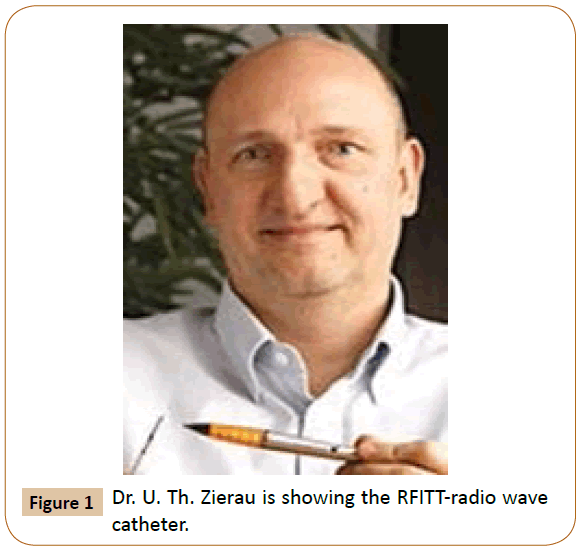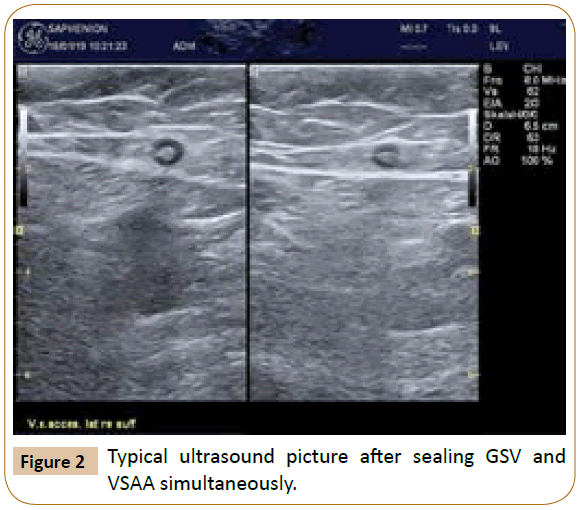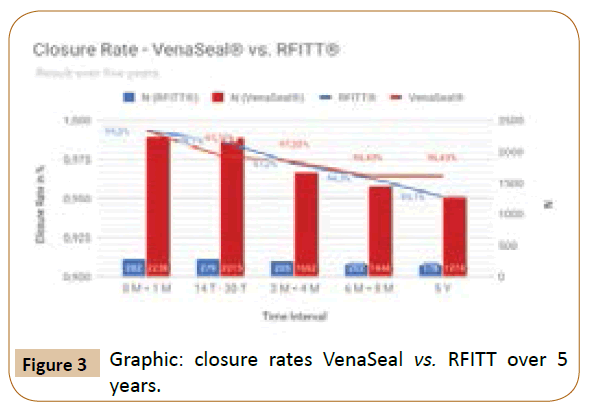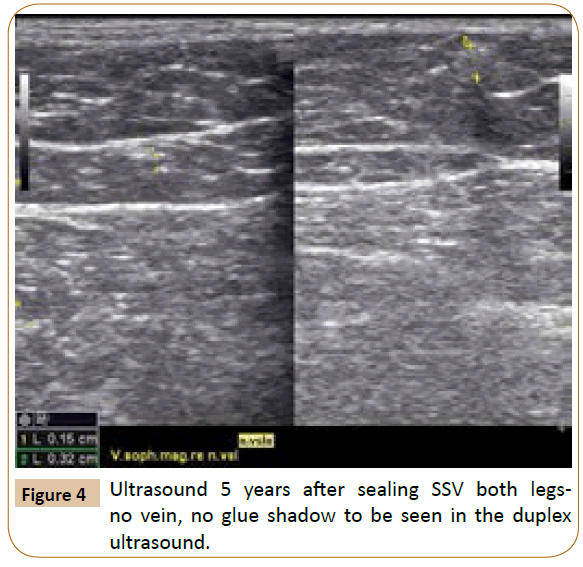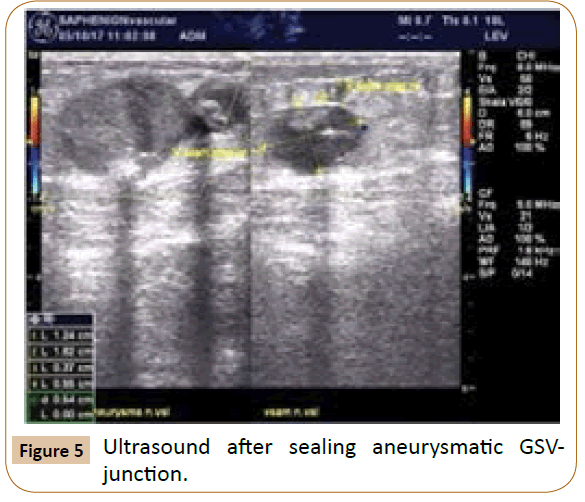Sealing Veins vs. Radiofrequency Ablation of Truncal Varicose Veins-5 Years Experience
Ulf Th Zierau
DOI10.21767/2573-4482.19.04.10
Ulf Th Zierau*
Founder and CEO of SAPHENION®-Surgeon, Vascular Surgeon, Phlebologist, Endovascular Specialist Artery, Endogenous Specialist Berlin/Rostock, Germany
- *Corresponding Author:
- Ulf Th. Zierau
Founder and CEO of SAPHENION®-Surgeon, Vascular Surgeon, Phlebologist, Endovascular Specialist Artery, Endogenous Specialist Berlin/Rostock, Germany
Tel: 0491708302447
E-mail: dr.zierau@yahoo.de
Received date: March 13, 2019; Accepted date: April 11, 2019; Published date: April 18, 2019
Citation: Zierau UT. Sealing Veins vs. Radiofrequency Ablation of Truncal Varicose Veins-5 Years Experience. J Vasc Endovasc Therapy 2019, Vol.4 No.1:10.
Copyright: © 2019 Zierau UT. This is an open-access article distributed under the terms of the Creative Commons Attribution License, which permits unrestricted use, distribution, and reproduction in any medium, provided the original author and source are credited.
Abstract
We report about 5 year-results in a single center retrospective comparative study with VenaSeal® Closure System in 2202 veins (1515 Great Saphenous Veins, GSV), 570 Short Saphenous Veins (SSV) vs. RFITT-ablation (Radiofrequency induced ThermoTherapy, RFITT) in 282 veins (181 GSV, 101 SSV). Our scientific paper compares the advantages and disadvantages of both methods again and represents the 60 month-results of our ambulant single-center study.
Keywords
Vein glue; Radiofrequency; Endovenous therapy; Thermal ablation; Nonthermal ablation
Introduction
Modern endovenous therapy
Since 20 years, the varicose is increasingly treated endovenous. In the beginning, the rather cumbersome VNUS®-Closure process and the easier-to-use linear laser. Followed in 2006/2007 the bipolar RFITT®-catheter and the VNUS®-ClosureFast system as well as the radial laser. Also, the microwave catheter was introduced in some countries.
Thermal ablation
All these methods are thermal therapies and all they need general or tumescence anesthesia. All they are working with high temperature and the result is an overcooked (RFITT) or overburned (laser) vein wall of the truncal varicose veins (3, 7, 8) [1-3]. By the way, these are very effective but also very painful tmethod with a great number of side effects. Main Thing is the irritation and destruction of peripheral nerve fibers and injured lymph vessels.
These side effects we have seen very often (25% of all cases) in our own work with thermal ablation systems since 2001. So it was an important concern to find another endovenous option with a high degree of effectiveness but without this high number of side effects (Figure 1).
Nonthermal ablation
In recent years, many experiences in endoluminal endovenous therapy have been collected, quality criteria established and standards developed for the various techniques. 16 years ago, apart from the thermal therapy concepts of radiofrequency and laser, the development of a simple but very effective method of sealing the truncal varicose vein, the VenaSeal®-Closure technique, began.
Approval in Europe, Canada, and the USA
Following CE-approval in autumn 2011, several venous centers in Germany and Europe began using the vein glue. Meanwhile, more than 35 centers are successfully working with the new therapy system (Figure 2).
In 2014/2015, the system was also approved in Canada and the USA. Since 2018, VenaSeal technology in the USA has been mandatory for insurance companies.
We were looking to find another way for endovenous treatment and want to show our own experiences with thermal and nonthermal techniques. The nonthermal way is the better one not only in our opinion [1,3-8].
Material and Methods
From 1st of August 2012 to 28th February 2019 (79 months), vein glue was used to occlude the vein in 2202 truncal veins, and 282 truncal veins were treated with the RFITT®-system (Figure 3).
The only inclusion criterion was a second to fourth-degree varicose veins Hach in the GSV and degree II after Hach in the SSV. Other selection criterions were not existent-the patients were asked and they have selected the therapy after extensive medical education.
The maximum treated venous diameter was 2.8 cm in the venous glue group and 2.5 cm in the radiofrequency procedure group. The follow-up period of our study was a maximum of 60 months.
With the vein glue the GSV was treated in 1515 cases and the SSV in 570 cases. While we aimed at the use of the vein glue, if possible, the simultaneous treatment of all insufficient truncal veins, in the group of radiofrequency patients in most cases 1-2 truncal veins were treated. The radio frequency procedure was used in the treatment of 282 veins, of which 181 were GSV and 101 SSV.
Sealing veins were performed under mild Dormicum sedation or under local anesthesia and concurrent music therapy for venous access. Radiofrequency therapy was performed in analgesic sedation in addition to tumescence or general anesthesia. All patients were followed up on the first, 7th and 30th day, six and twelve months and then once a year by clinical and duplex sonography in one study (own quality management).
Our method is according to the Ethical aspects of the Helsinki Declaration.
Results and Discussion
In the course of 79 months of use of the vein glue VenaSeal®, 1265 cases could be followed up over 60 months by duplex sonography. We found 79 recanalizations over all the time. The occlusion rate is 96.41%.
In the radiofrequency group, all 282 patients have been followed up to 60 months post op. There were 14 recanalizations during this period (4.9%).
The closure rate over 60 months for radiofrequency therapy for the total number of treatments on 256 truncal veins is 95.1% (Figure 3).
The subjectively perceived pain score on the first postoperative day (range 1-10) was between 1 and 3 for the vein adhesive and for the RFITT procedure between 3 and 8 (4.1). It decreased to 1.1 in the vein glue up to the seventh postoperative day and to 2.7 in the radiofrequency therapy [1,3-6,8,9].
In 7.9% we saw a nonspecific inflammatory skin reaction postoperatively after about six to ten days in the sealing vein group (Figure 4).
In the radiofrequency patients, a thermal or inflammatory skin reaction was seen in 25 cases (8.9%) as early as the first to third postoperative day in 11 cases (3.9%) still detectable after three months.
Especially in abnormal anatomic subcutaneous truncal veins, this skin reaction is generally very long lasting in thermal processes in two cases (0.7%).
An open burn of the skin of the thigh was found in this group, whereas a purulent tissue inflammation had to be openly treated surgically (0.35%).
The major problem with RFITT®, however, is and remains, the occurrence of abnormal sensations, deafness feelings, and paresthesia. In our group, 71 patients (25.2%) reported prolonged (>30 days) persistent paraesthesia and deafness [1,3,4,6,8,10].
While 14% reported deafness or abnormalities when treating GSV, this number increases to>30% in SSV treatment. In part, these neurological dysfunctions of the sensory nerves lasted up to 36 months [11-14].
This high number of nerve irritations in the treatment of SSV leaves us here clearly a recommendation for the sealing vein therapy pronounce. In the meantime, this has become an international standard as well (Figure 5).
In the case of sealing varicose veins, we have almost completely dispensed with the compression therapy. In the radiofrequency procedure, all patients wear a compression stocking for 14 to 21 days.
Conclusion
Nonthermal and nontumescent vein glue with a bio resorptive tissue glue ultrasound after 5 years, there is no glue to be seen) is the latest technological development in a series of endovenous therapy procedures. Side effects, such as those known from the laser or radiofrequency therapy, do not play a significant role here. We do not need general anesthesia or tumescent anesthesia, and in most cases no postoperative compression is necessary. The significantly reduced side effects and a very low pain score during and after treatment are decided advantages compared to laser or radiofrequency. We see no abnormal sensations, no deafness feelings, no paraesthesia, no motor disturbances, and no phlebitis.
Rarely it comes in connection with a recognizable by a red skin discoloration temporary foreign body reaction (7.9% of all cases)- to a longer visible line-shaped skin pigmentation.
The actual point of view of our experiences, we recommend sealing veins in typical truncal varicose veins of GSV, SSV or VSAA.
We can also treat ectatic and aneurysmatic veins very effective.
Conflict of Interest
There are no conflicts of interest; the present research paper was not sponsored.
References
- Gibson K, Morrison N, Kolluri R, Vasquez M, Weiss R, et al. (2018) Twenty-four month results from a randomized trial of cyanoacrylate closure versus radiofrequency ablation for the treatment of incompetent great saphenous veins. J Vasc Surg Venous Lymphat Disord 6: 606-613.
- Rasmussen LH, Bjoern L, Lawaetz M, Lawaetz B, Blemings A, et al. (2010) Randomised clinical trial comparing endovenous laser ablation with stripping of the great saphenous vein: clinical outcome and recurrence after 2 years. Eur J vasc Endovasc Surg 39: 630-635.
- Zierau UT (2016) Venenverklebung versus Radiofrequenztherapie bei Varikosis. Vasomed 5: 212-216.
- Almeida J, Javier J, Mackay E, Bautista C, Proebstle T (2012) Cyanoacrylate glue great saphenous vein ablation: preliminary 180-day follow-up of a first-in-man feasibility study of a no-compression-no-local-anesthesia technique. J Vasc Surg 55: 297.
- Lawson J, Gauw S, Vlijmen C, Pronk P, Gaastra M, et al. (2013) Wittens: Sapheon: the solution? Phlebology 1: 1-4
- Morrison N, Gibson K (2014) Veclose Study: Preliminary Month 1 Data. In 2nd Annual Cyanoacrylate Embolization Symposium, Mainz 18.
- Proebstle TM, Alm J, Rasmussen L, Dimitri S, Lawson J, et al. (2013) The european multicenter study on cyanoacrylate embolization of refluxing great saphenous veins without tumescent anesthesia and without compression therapy. J Vasc Surg: Venous Lymphat Disord 1: 101.
- https://www.saphenion.de/news/venenkleber-vs-radiofrequenz-bei-varicosis-5-jahres-verlauf/
- Almeida JI, Min RJ, Raabe R, McLean DJ, Madsen M (2011) Cyanoacrylate adhesive for the closure of truncal veins: 60-day swine model results. Vasc Endovasc surg 45: 631-635.
- https://www.saphenion.de/news/venaseal-radiofrequency-and-laserablation-in-varicose-veins-best-one/
- Gibson K, Morrison N, Kolluri R, Vasquez M, Weiss R, et al. (2018) Twenty-four month results from a randomized trial of cyanoacrylate closure versus radiofrequency ablation for the treatment of incompetent great saphenous veins. J Vasc Surg: Venous Lymphat Disord 6: 606-613.
- Morrison N, Kolluri R, Vasquez M, Madsen M, Jones A et al. (2018) Comparison of cyanoacrylate closure and radiofrequency ablation for the treatment of incompetent great saphenous veins: 36-Month outcomes of the VeClose randomized controlled trial. Phlebology.
- Chan YC, Law Y, Cheung GC, Ting AC, Cheng SW (2017) Cyanoacrylate glue used to treat great saphenous reflux: measures of outcome. Phlebology 32: 99-106.
- https://vsearch.nlm.nih.gov/vivisimo/cgi-bin/query-meta?query=venaseal&v%3Aproject=nlm-main-website
- https://www.accessdata.fda.gov/scripts/cdrh/cfdocs/cfmaude/detail.cfm?mdrfoi__id=4841327
Open Access Journals
- Aquaculture & Veterinary Science
- Chemistry & Chemical Sciences
- Clinical Sciences
- Engineering
- General Science
- Genetics & Molecular Biology
- Health Care & Nursing
- Immunology & Microbiology
- Materials Science
- Mathematics & Physics
- Medical Sciences
- Neurology & Psychiatry
- Oncology & Cancer Science
- Pharmaceutical Sciences
